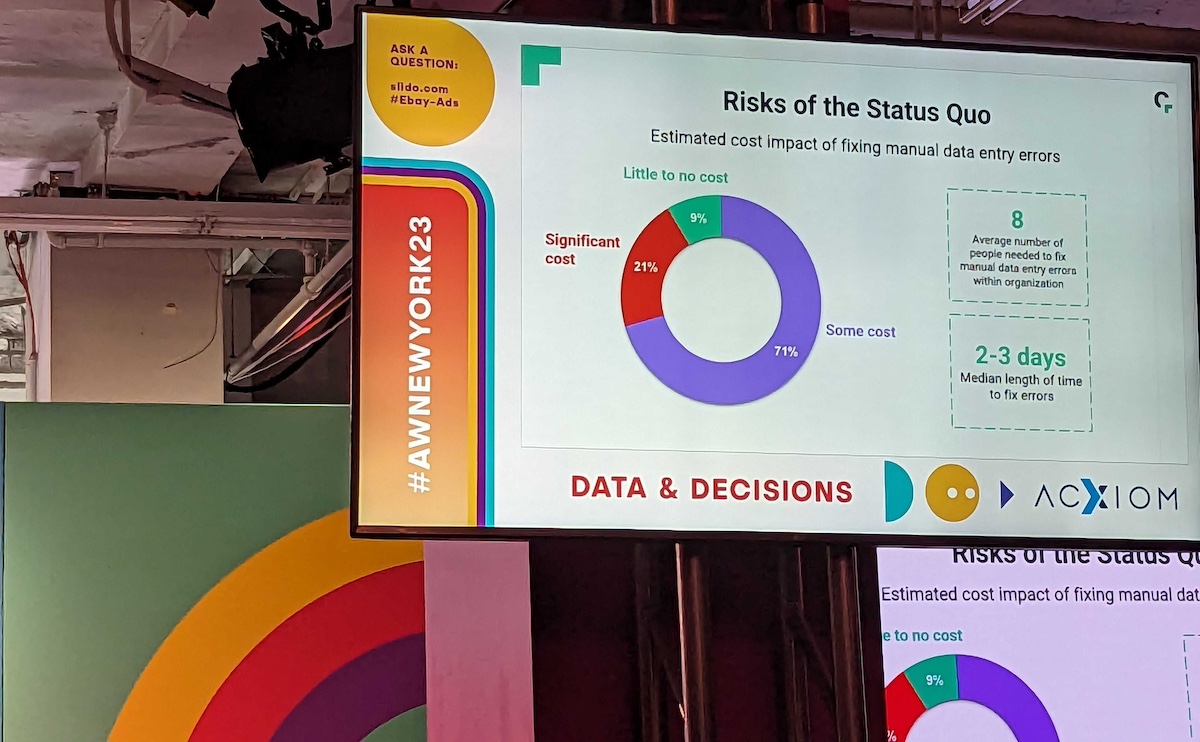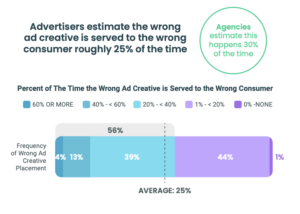8 Expert Tips on Implementing Data Standards

When regulations, technology, and consumer expectations are constantly changing, keeping the analytics status quo isn’t an option.
So during Advertising Week New York, we gathered four marketing and advertising experts to discuss the current state and future needs of marketing data: Claravine’s own Chief Growth Officer Chris Comstock, Advertiser Perceptions’ VP of Business Intelligence Lauren Fisher, Snowflake’s Industry Field CTO of Advertising and Marketing Jim Warner, and EssenceMediaCom’s VP of Global Data Management Tim Fogarty.
We dissected findings from our recent study, The State of Modern Marketing Data Standards, which surveyed over 140 advertisers in organizations that spend more than $50M annually on digital advertising. And our conversation touched on both foundational concepts and trending topics, including how data standards facilitate trust, the prevalence of data clean rooms, and marketers’ overconfidence in handling AI-generated creative.
Read on for eight key takeaways from our conversation, or watch the full recording: Regain Control in a Privacy Centric Future with Data Standards.
1) The definition of data standards
Implementing data standards is all about establishing trust in the measurement and data we’re generating through digital marketing.
A data standards strategy functions like a playbook, dictating:
- How your team formats, tags, and structures data
- How data is used, shared, and manipulated
- How data is managed to integrate across systems
Data standards are essential because marketing data can get incredibly messy for teams who work across multiple tools like ad platforms, CDPs, CRMs, and marketing automation solutions.
“When we talk about standards for phone numbers or addresses, we don’t think twice about that — we know what it means,” says Chris. “But when you look at ad server reports or compare one dashboard versus another — trying to translate and understand what those things mean, especially if somebody else created it, is really challenging.”
As Jim puts it, data standards help teams move beyond “Franken-names: those blobs of text that come out of your ad server”.
Rather than trying to decipher the difference between fields like “display_” and “Disc_” and “disc_”, data standards (like naming conventions, formatting, and data management) make it easy for teams to use, share, and trust marketing data while staying in compliance with ever-evolving consumer privacy regulations.
2) The value of embracing data standards — and the risks of falling behind
Our survey respondents understand the value of data standards, with 91% agreeing that putting a data standards practice in place is a must to move forward in a privacy-centric way. Additionally, 86% say that if they don’t have data standards practices, their organization will fall behind competitors or lose market share over time.
Our expert panelists identified a few specific ways the value of data standards — and the risk of not implementing them — comes to life.
“Understanding what your data is and what it means, across your full stack, is essential to effectively target and measure,” says Jim.
Chris highlights that time-to-insight is greatly impacted by data standards. “We see a lot of customers take weeks or months to actually build dashboards, understand the data, understand who created what campaign, if it was set up properly, and actually trust it. We see that time to insight and decision optimization be completely shortened down if there’s a common understanding of the data standards.”
And Tim adds that data standards help minimize the potential for inevitable human error to damage data trust. “At every step where you have a transformation, there are still human hands touching or factoring into the creation and passing along of this data — for good and for bad,” Tim says. “There have to be steps in place to make sure that our data is good and meets our expectations. Without that, you lose trust, you lose use, and it’s just kind of a waste of time and money.”
3) The biggest challenge: accessing data in the first place
Understanding the value of data standards is one thing, but actually putting them into practice is a different beast. And one of the key benefits — standardizing data sets so they can be shared across teams, systems, and partners — is one of the most difficult to realize.
Our survey showed that 41% of companies used an API or third-party partner for sharing audience segment data — and this modern approach was more commonly used by advertisers with data standards in place. But the second most common method for sharing data was emailing around Excel files or Sheets.
In the era of data privacy, this finding is an eyebrow-raiser. And according to our expert panelists, much of the challenge revolves around data access.
“Broadly speaking, I think there are two types of organizations,” says Jim. “Those who have invested in a single source of truth for their data, and those that haven’t. And even when an organization has invested in a single source of truth, that doesn’t mean all the teams within that organization have access to that data. It’s really about organizational alignment around data and systems.”
As Lauren points out, Excel is still widely used because it’s the easiest way for companies to share data internally. And even in cases where organizations use an API, the person responsible for uploading that data isn’t always the same person who has permission to pull it.
“How many IT teams are thinking about getting data over to their agency?” Jim says. “And planning for how that translation and transfer of data is going to happen? Not many.”
While the positive intention may be to keep data protected and separated so teams aren’t inappropriately operating systems with sensitive data, ultimately, those silos make it challenging to share data in a standardized, privacy-friendly way.
4) Why advertisers fail at personalization
 Our research report shows that respondents said one in four of their ads were served to the wrong consumer — and for agencies, that was even higher at three in 10.
Our research report shows that respondents said one in four of their ads were served to the wrong consumer — and for agencies, that was even higher at three in 10.
“Everyone talks about personalization, but obviously it’s a challenge to execute at scale,” says Lauren. “And this is even more difficult with the signal loss coming into play.”
In Tim’s experience, advertisers need to retroactively check on the accuracy of their personalization. While that’s not the simple, easy answer, he believes it’s what’s necessary.
“Every ad server thinks I speak Spanish, and I do not speak Spanish,” Tim says. “I get a lot of those ads, and it’s because no one’s checking and doing that due diligence. It requires a duplication of effort and a healthy bit of distrust that we don’t always want to acknowledge has to exist to be successful in the space, but we need to do it. Evaluate these segments, enrich it with other data sets, and understand exactly whether your ads were served to the right person.”
And that retrospective work of evaluating campaigns and personalization success will be made much easier with data standards in place to ensure consistency across aggregated data sets.
5) The pros and cons of data clean rooms
Our panelists also touched on one of the hottest topics in marketing data: clean rooms.
“Data clean rooms are great,” says Jim. “They allow two or more parties to come together and share data in a privacy-safe way. But ultimately, the clean room is only as good as the data that you put in. So if you’re putting in messy data — if you’re putting in exposure information where you don’t know if it was a display ad or a CTV ad — then you’re not going to be able to do the measurement you want.”
According to Chris and Lauren, many advertisers are already effectively using data clean rooms like Facebook and Amazon. But the fragmentation of using multiple ad platforms and multiple clean rooms introduces more complexity.
“It’s great that we have privacy sharing and not having to send log files around,” says Chris. “But it becomes even more important to understand the inputs and outputs of all these different data sets as things are getting aggregated. Brands need to organize and prioritize the naming conventions and the relationship around what creative message was targeted. As you look at those aggregate data sources, it just becomes essential.”
6) Collective overconfidence in gen AI
Our survey results showed that around 40% of advertisers are currently using generative AI for ad creative, and 72% are confident in their ability to property tag and track all assets created via gen AI.
Our panelists were more skeptical, to put it lightly.
“I think 72% being confident they can tag gen AI content is crazy,” Jim says. “Before I came to Snowflake, I was CTO of a measurement company, and I don’t think people did a good job of tagging the creative they could make by hand. There’s so many shapes and variations, and so much of the measurement we were doing was through the third-party ad server, even if the creative itself was site-served. So half the time, we had no idea what the creative was, and that was before we could use gen AI to make an order of magnitude more creative. Just because you’re having AI make some creative variations doesn’t mean you’ve freed yourself from the need for those standards, processes, consistency, and tagging.”
Chris agrees that teams need to be conscious of the burden that producing more AI-generated content assets puts on operations teams. “You’ve got to understand that when you’re going to measure this, you need to have standardization upfront,” he says. “It’s great that we can create more assets, but you’re also going to want to know what’s working and what’s not.”
Additionally, Chris points to brand safety as a significant risk — both to a company’s reputation and its internal operations velocity. “You have to be thoughtful around operations and the need to understand whether those assets are actually brand safe,” he says. “It may speed up the content creation process, but it may slow the overall process down — you’ve got to be thoughtful on the end-to-end process.”
7) The need to slow down, strategize, and prepare for change
Our survey shows that marketing and advertising leaders understand the importance of data standards — because these practices are essential for understanding and demonstrating the ROI and ROAS of campaigns. But, as our panelists know all too well, these strategies often take a backseat to more pressing organizational issues.

“You have to have the time and space to think, evaluate, and make the strategic decisions built on top of these processes,” says Tim. “Without that pause, it can’t happen. But realistically, if you’re told every morning at 7:30 that you need to hit X in revenue today, you’re probably not going to sit back and come up with a new strategy.”
Instead, leaders scramble to spend money in proven places to meet short-term goals — but unless you’re continuously able to think about and revise data strategies, you’ll watch your returns diminish over time. And if you don’t take time to prepare for inevitable changes to privacy protections, you’ll fall behind the competition.
“I hope this is finally the year cookies go away so we can stop talking about it,” says Chris. “You’ve got to prepare and adapt for change. Companies that are waiting for Apple or Google to dictate what they’re doing, instead of adopting change now, are ultimately going to fall behind.”
8) Advice for teams new to adopting data standards
Newcomers to data standards may understand the value, but be at a loss on where to start. We conducted a live poll during our panel, and found that 2 in 5 of our attendees didn’t have a data standards practice in place — but a quarter were working on one. So our panelists shared their expert advice.
“Most people say it takes about a year to really get a data standards practice moving,” says Lauren. “This isn’t something that happens overnight. It’s a journey.”
Chris agrees. “Start soon and start small,” he says. “Don’t wait for perfection or try to get everything right. The only thing we all know is that change is constant, so just get started.”
Tim also underscores the importance of just getting started — aiming for good-enough rather than perfection. “Understand what you’re trying to prove,” says Tim. “Understand the tools you’re using to prove that. And then make sure that it works as well as it can.”
Jim advises teams to give your people as much consideration as your tech stack. “Align the technology, yes, but also align your organization.”
And Lauren shared one final piece of advice. “Talk through the repercussions and benefits of putting these into place,” she says. “Give employees the power to come to you with their challenges.”
Start your data standards journey
Curious to see data standards in action? Take a quick product tour to learn how marketers activate their shared data language across people and technology in The Data Standards Cloud platform.



